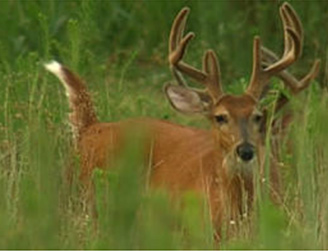Deer Nutrition
Introduction:
Deer are browers and not grazers like cattle. This means that deer move around and eat as they go. Cattle graze or stay in one place for a long time while eating. As deer move they eat a variety of items including buds, fresh growth on herbs and other plants, acorns, fruit, agricultural crops and items grown in food plots. Deer are runinants which means they chew a cud and their stomachs are in 4 parts.
Corn, acorns and general browse provide 5-8% protein. Numerous studies have shown that deer need 16-20% protein to reach genetic potential and for the herd to be at its greatest possible health. A good food plot program will produce an average of about 24% protein. Some food plot crops such as forage soybeans, burgundy beans, cowpeas, lab lab and winter peas provide 28-40% protein. Studies have shown that deer will eat between 25% and 75% of their diet in food plots. I think 25% to 50% is a much more common number. Higher percentages are achieved with the greatest variety in the food plots due to deer selection of plants more often at specific stages of development and by providing food plots on a year around basis. At 40% of a deer’s diet in high quality food plots then the average starts to reach the 16% level for protein.
Protein is needed throughout the year for the general health of the deer herd. During the fall carbohydrates are consumed in larger quantities. Corn, acorns and fruit will supply carbohydrates. Variety is the key.
Excessive corn consumption can cause toxic acidosis. This will not happen in a corn field but can happen when deer eat a pile of corn.
It is also important to note that bucks develop their antlers starting in February and continuing to early fall. Does drop their fawns during the late spring and need quality nourishment during this time. Fawns need a very high quality diet to develop. This is why it is important to supply food plots on a year around basis.
Antler Makeup
Antlers are about 45% protein, 22% calcium and 11% phosphorous. Magnesium is also present in decent levels in antlers. As noted higher concentrations of protein are available in food plots than in native browse. Calcium is available in all forms of lime. Forage Tech mineral mix contains 16% calcium. Calcium is also consusmed in native browse but at low levels. Phosphorous is available in native browse with some locations containing much higher phosphorous levels than other levels. Forage Tech mineral mix contains 8% phosphorous. Phosphorous is also avialable as the second number in a 3 number fertilizer mix such as our food plot fertilizer.  Magnesium is available in agricultural ground limestone but not in pelleted lime. The supplier of the lime can tell you if magnesium is present in their lime or not. You can check the bag label on lime bags. The filler in our wildlife food plot fertilizer is agricultural limestone so we have magnesium in our fertilizer and in our mineral mix.
Magnesium is available in agricultural ground limestone but not in pelleted lime. The supplier of the lime can tell you if magnesium is present in their lime or not. You can check the bag label on lime bags. The filler in our wildlife food plot fertilizer is agricultural limestone so we have magnesium in our fertilizer and in our mineral mix.
